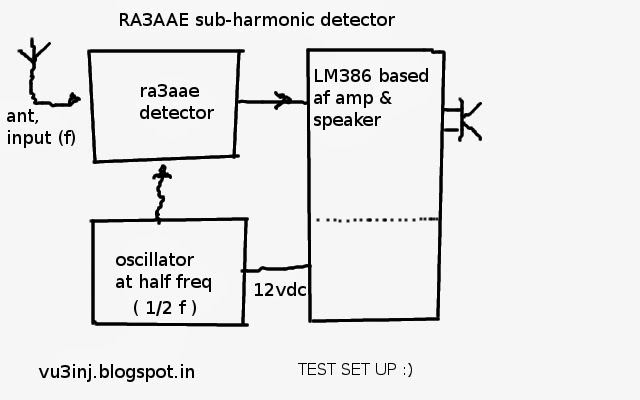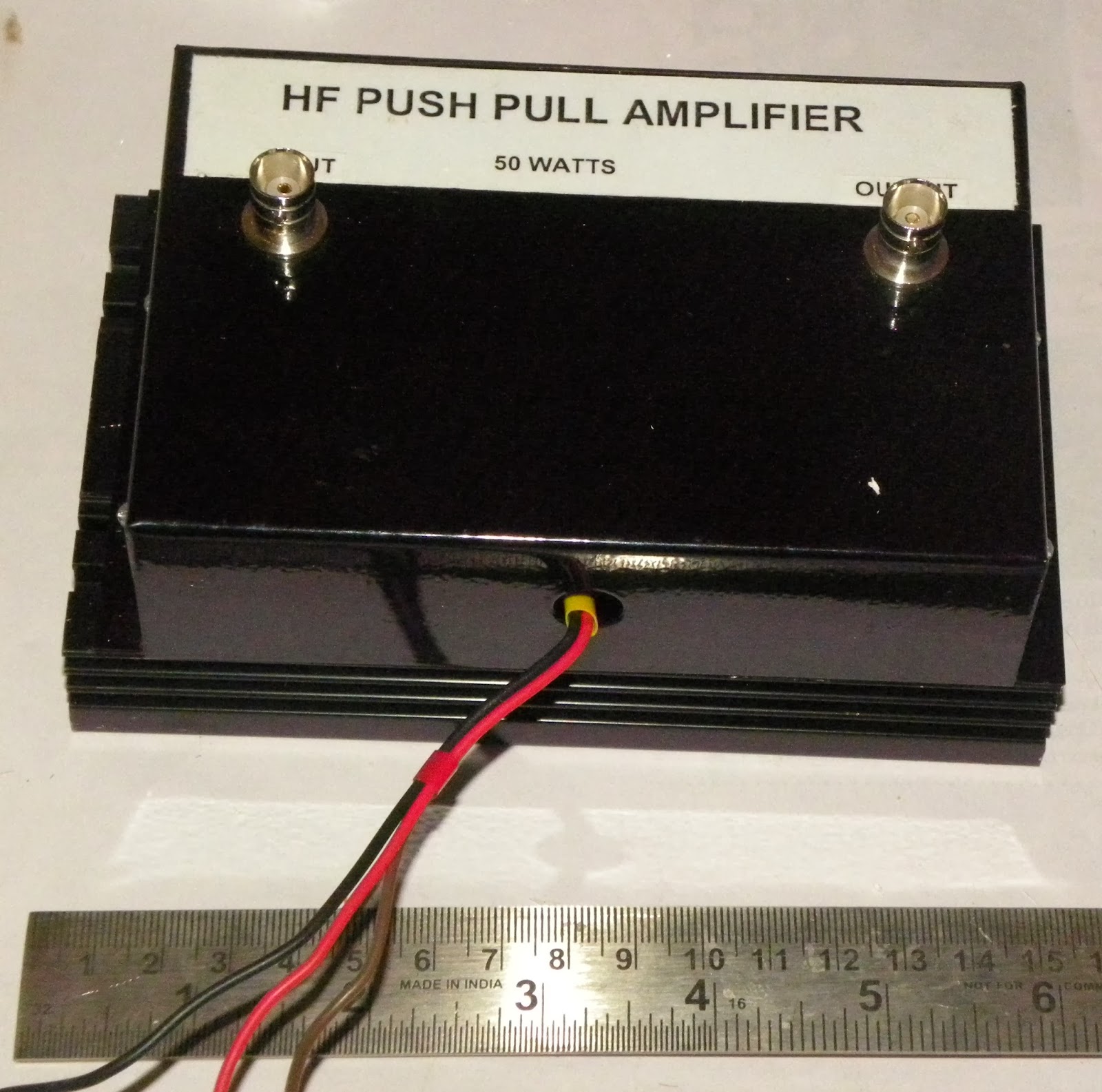ra3aae
DIRECT CONVERSION RECEIVERS.
RA3AAE sub-harmonics detector
You would not beleive that, withing 10 minutes of the brewing it started working. I did not expected the performance to be so good. so i will stay with this detectors.
beauty is that for 40 meter your oscillator needs to be on 80 meter. i can make the 80 meter oscillator using the ceramic resonators. it has half the signal frequency. so can be used as QSK signal monitor. will develope it further to a fullfledged receiver for 40 meter.
Working test :-
For af amplifications a lm386 bases complete audio amp box was used. (see singal tracer post). a small 1 meter wire was used a s antenna.
I dont understand the preset (p1) but when put into the exact half position quality of sound is okey , volume is low. May be it is used to balance-cancel the AM breakthrough....
I am using this ckt. But would like to go for a commond base rf input amp and an common base AF AMP. the hiss of common emmiter in af amp stage is untolerable. My purpose of listening to the cw beacons is solved. so, its okey for me. will box it and if i make further refinements will inform. there need to taken care of the low impedance. p1 has to be low 220 ohm .... when i connected it with big antenna there was problem of complete am blanket so i have to redisign and make a good rf front end taking above issues.
CONCLUSION
:: THIS DETECTOR CIRCUIT WORKS ::
Further:-
there are lots of the pair of xtals available ie. (24mhz-12mhz), (20mhz-10mhz,) (10mhz&5mhz), ( 8.866 mhz & 4.433 mhz) etc. so they can be used to test this detector and possibly use it in some-way or others. these detectors are better than other diode detectors in practical use. try it yourself !
Please dont use it as the front end mixer. I have never encountered ckt for using it as the frequency changer. However, it works good as the product detector. why ? i dont know. It requires very low oscillator power In fact there is needs to reduce the power. I tried to put lesser value capacitor for taking the output from the oscillators. I have not heard the 40 meter signal on air as i am using it as a very simple signal monitor receiver for vwn tx on 40 meter. will update more if i find up anything useful... (19march2014)
This is one of my project which was realized within half hours including all the r&d. I am surprized why in VU, hams are not using this ckt ? i dont find any problem with it.
 | |
| ra3aae subharmonics detector |
DIRECT CONVERSION RECEIVERS.
when
making the 14316kc cw and dsb transmitters one receiver was needed for
monitoring the local signals. i
have tried few projects with the direct conversion receivers. I had tried successfully the ring diode mixers but now a days dont have the ferrites. What a problem. due to this despite the caution of a good brewer (VU2ESE). I tried the ic based receiver.He suggested to use DC-40 receiver (ARRL origin) and re-produced world over.
TA7358AP. a 9PIN sil package fm front end ic as used by py2ohh it worked but there was problem heavy am breakthroug could work as the local monitor but junked it. later on i found that py2ohh also used it as building block for his rigs IF stage. i should have taken the words of OM very seriously.
This TA7358 will work within the superhet receiver as a second detector very fabulously. This ic also gives good performance as the mixers, frequency converters and A very very good DSB modulators. So, i love this ic but not worth for a dc receiver.
So, back again looking for a good receiver to monitor all the signal from homebrew transmitters. LRR40 never worked. My main SAIT Marine is failing me on 40 meter in fact less than 10mhz it is becoming insensitive.a serious problem. I was upset.
TA7358AP. a 9PIN sil package fm front end ic as used by py2ohh it worked but there was problem heavy am breakthroug could work as the local monitor but junked it. later on i found that py2ohh also used it as building block for his rigs IF stage. i should have taken the words of OM very seriously.
This TA7358 will work within the superhet receiver as a second detector very fabulously. This ic also gives good performance as the mixers, frequency converters and A very very good DSB modulators. So, i love this ic but not worth for a dc receiver.
So, back again looking for a good receiver to monitor all the signal from homebrew transmitters. LRR40 never worked. My main SAIT Marine is failing me on 40 meter in fact less than 10mhz it is becoming insensitive.a serious problem. I was upset.
Then
as a last try, there were two options 1.to work with the digital switches (4066) or
2. these un-conventional looking diode sub-harmonics detecktor. infact russian hams are very fond of this detectors.
RA3AAE sub-harmonics detector
saw few ckts on net but finally decided to go with PA2OHH
( HE IS DIFFERENT FROM A BRAZINLIAN HAM-PY2OHH. PY2OHH has made the
ararinha). This european hams has done a good work on this
sub-harmonics detector. he has extensively used it in his rigs.
 | |
| back-side of pd |
beauty is that for 40 meter your oscillator needs to be on 80 meter. i can make the 80 meter oscillator using the ceramic resonators. it has half the signal frequency. so can be used as QSK signal monitor. will develope it further to a fullfledged receiver for 40 meter.
 |
| CLOSE UP VIEW RA3AAE DETECTOR |
Working test :-
For af amplifications a lm386 bases complete audio amp box was used. (see singal tracer post). a small 1 meter wire was used a s antenna.
 |
| test set up |
from left, wire-antenna,(tuned ckt is back of first board), ra3aae detector, oscillator. in the back-ground sketches of the the various ckt using this detektor.
 |
| test-setup |
I dont understand the preset (p1) but when put into the exact half position quality of sound is okey , volume is low. May be it is used to balance-cancel the AM breakthrough....
How to choose diodes:-
there was no guidelines. but, i understand that it is a balanced ckt so, measured the 1n4148 diodes forward resitance in the digital multimeter in 2k range. the two diodes which gave me the same reading were choosed.may be one or two ohm difference will work !
Circuit ( presently used as on 22march2014):-
there was no guidelines. but, i understand that it is a balanced ckt so, measured the 1n4148 diodes forward resitance in the digital multimeter in 2k range. the two diodes which gave me the same reading were choosed.may be one or two ohm difference will work !
Circuit ( presently used as on 22march2014):-
 |
| my ra3aae experimenta ckt |
CONCLUSION
:: THIS DETECTOR CIRCUIT WORKS ::
Further:-
there are lots of the pair of xtals available ie. (24mhz-12mhz), (20mhz-10mhz,) (10mhz&5mhz), ( 8.866 mhz & 4.433 mhz) etc. so they can be used to test this detector and possibly use it in some-way or others. these detectors are better than other diode detectors in practical use. try it yourself !
Please dont use it as the front end mixer. I have never encountered ckt for using it as the frequency changer. However, it works good as the product detector. why ? i dont know. It requires very low oscillator power In fact there is needs to reduce the power. I tried to put lesser value capacitor for taking the output from the oscillators. I have not heard the 40 meter signal on air as i am using it as a very simple signal monitor receiver for vwn tx on 40 meter. will update more if i find up anything useful... (19march2014)
This is one of my project which was realized within half hours including all the r&d. I am surprized why in VU, hams are not using this ckt ? i dont find any problem with it.
Reading sources:-
I have taken the help of two sites.
First is above mentioned PA2OHH. for taking the design. further-
Second helpful reading is the http:// www.ke3ij.com / please aslo visit it. there is a beautiful explanations and his own experiments is shown. worth see his site.
g3bxm has used it in WSPR applications. worth to see his blog also. Roger G3XBM's Amateur Radio Blog: Roger G3XBM's Amateur Radio Blog:
I have taken the help of two sites.
First is above mentioned PA2OHH. for taking the design. further-
Second helpful reading is the http:// www.ke3ij.com / please aslo visit it. there is a beautiful explanations and his own experiments is shown. worth see his site.
g3bxm has used it in WSPR applications. worth to see his blog also. Roger G3XBM's Amateur Radio Blog: Roger G3XBM's Amateur Radio Blog:
thats is folk. use this strange wheel. it was always there. but we were not beleiving it....








